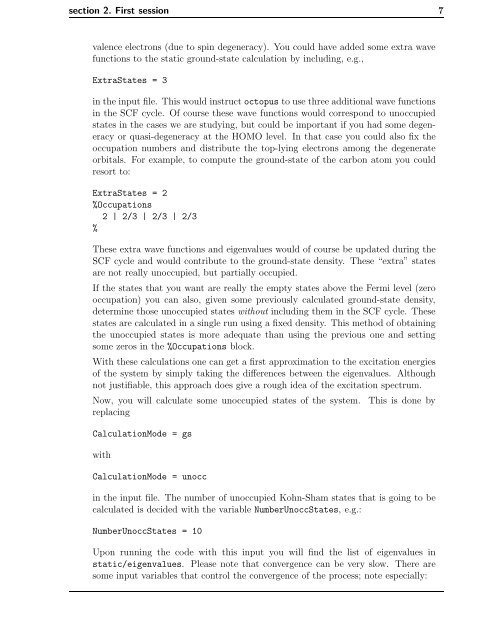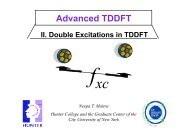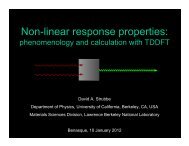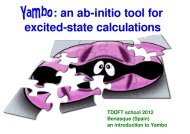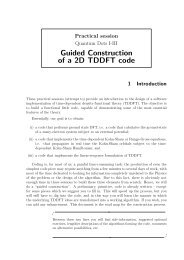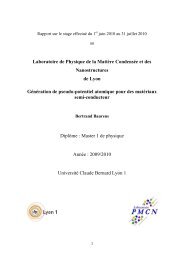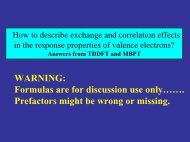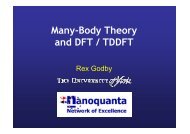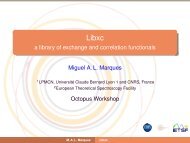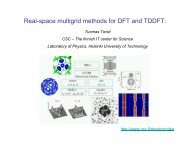Introduction to the octopus code - TDDFT.org
Introduction to the octopus code - TDDFT.org
Introduction to the octopus code - TDDFT.org
You also want an ePaper? Increase the reach of your titles
YUMPU automatically turns print PDFs into web optimized ePapers that Google loves.
section 2. First session 7<br />
valence electrons (due <strong>to</strong> spin degeneracy). You could have added some extra wave<br />
functions <strong>to</strong> <strong>the</strong> static ground-state calculation by including, e.g.,<br />
ExtraStates = 3<br />
in <strong>the</strong> input file. This would instruct oc<strong>to</strong>pus <strong>to</strong> use three additional wave functions<br />
in <strong>the</strong> SCF cycle. Of course <strong>the</strong>se wave functions would correspond <strong>to</strong> unoccupied<br />
states in <strong>the</strong> cases we are studying, but could be important if you had some degeneracy<br />
or quasi-degeneracy at <strong>the</strong> HOMO level. In that case you could also fix <strong>the</strong><br />
occupation numbers and distribute <strong>the</strong> <strong>to</strong>p-lying electrons among <strong>the</strong> degenerate<br />
orbitals. For example, <strong>to</strong> compute <strong>the</strong> ground-state of <strong>the</strong> carbon a<strong>to</strong>m you could<br />
resort <strong>to</strong>:<br />
ExtraStates = 2<br />
%Occupations<br />
2 | 2/3 | 2/3 | 2/3<br />
%<br />
These extra wave functions and eigenvalues would of course be updated during <strong>the</strong><br />
SCF cycle and would contribute <strong>to</strong> <strong>the</strong> ground-state density. These “extra” states<br />
are not really unoccupied, but partially occupied.<br />
If <strong>the</strong> states that you want are really <strong>the</strong> empty states above <strong>the</strong> Fermi level (zero<br />
occupation) you can also, given some previously calculated ground-state density,<br />
determine those unoccupied states without including <strong>the</strong>m in <strong>the</strong> SCF cycle. These<br />
states are calculated in a single run using a fixed density. This method of obtaining<br />
<strong>the</strong> unoccupied states is more adequate than using <strong>the</strong> previous one and setting<br />
some zeros in <strong>the</strong> %Occupations block.<br />
With <strong>the</strong>se calculations one can get a first approximation <strong>to</strong> <strong>the</strong> excitation energies<br />
of <strong>the</strong> system by simply taking <strong>the</strong> differences between <strong>the</strong> eigenvalues. Although<br />
not justifiable, this approach does give a rough idea of <strong>the</strong> excitation spectrum.<br />
Now, you will calculate some unoccupied states of <strong>the</strong> system. This is done by<br />
replacing<br />
CalculationMode = gs<br />
with<br />
CalculationMode = unocc<br />
in <strong>the</strong> input file. The number of unoccupied Kohn-Sham states that is going <strong>to</strong> be<br />
calculated is decided with <strong>the</strong> variable NumberUnoccStates, e.g.:<br />
NumberUnoccStates = 10<br />
Upon running <strong>the</strong> <strong>code</strong> with this input you will find <strong>the</strong> list of eigenvalues in<br />
static/eigenvalues. Please note that convergence can be very slow. There are<br />
some input variables that control <strong>the</strong> convergence of <strong>the</strong> process; note especially:


